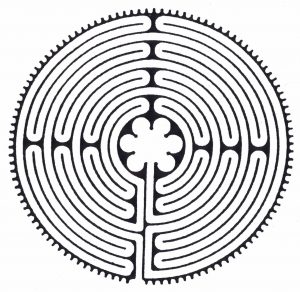 What is a labyrinth? From The Labyrinth Society web page: A labyrinth is a single path or unicursal tool for personal, psychological and spiritual transformation. Labyrinths are thought to enhance right brain activity.
What is a labyrinth? From The Labyrinth Society web page: A labyrinth is a single path or unicursal tool for personal, psychological and spiritual transformation. Labyrinths are thought to enhance right brain activity.
Where did labyrinths begin? Labyrinths have been used for at least 3,500 years. There is evidence of the use of labyrinths in Crete, Scandinavia, Italy and throughout North America.
When did Christians start using labyrinths? Labyrinths were used in early Christian worship during the Middle Ages. Some sources suggest that people walked labyrinths as an alternative to making a pilgrimage to the Holy Land; other sources say that the purpose of the labyrinth isn’t clear.
And today? Today labyrinths are used in a variety of settings: churches, hospitals, seminaries. Why did we decide to build a labyrinth? During the past decade we have invited Lynn Brown, a trained labyrinth facilitator, to come with her canvas labyrinth so that we might experience walking a labyrinth. Many of us found this practice to be calming, centering and fun. A small group of church members got together to see if we might build our own permanent labyrinth. We received a small Challenge to Change grant from the Hudson River Presbytery to get us started. Lynn Brown has helped us as we discerned where the labyrinth should go. After a few “false starts” we found the perfect place for it, and so work began.
How do we expect to use our labyrinth? We want our labyrinth to be used by our church, our community and anyone who would benefit from walking a labyrinth. We will list it on the world-wide labyrinth locator. We will use ours as a “prayer labyrinth,” as a way of guiding us into prayer and as a tool to help us be open to the presence of God.
What has happened so far? Many, many volunteers helped clear the ground in the back of the parking lot. Dick Seymour cleared the most stubborn roots with his backhoe. We then put down landscape cloth and topsoil, and Dick seeded the area. During this hot and dry summer we watered the grass. Once the grass came up, we ordered the bricks-about 1,000 of them! Volunteers laid the bricks on the lines that Lynn Brown had laid out for our labyrinth.
What’s left to do? We’re now at the “hard part” – digging in the bricks. This involves two different kinds of tasks: digging the trenches and setting the bricks in the dirt. Digging the trenches requires a fair amount of strength; the ground is quite compressed and dry. We’ve been watering it to loosen it up a bit. Setting the bricks in the dirt requires patience and attention to detail; each brick needs to be placed “just so” and then set firmly into the ground. We are hoping to dedicate our labyrinth this fall, so there’s a sense of urgency about the work. We’ll be working over the first three Saturdays in October.
If you can join us for either task please let Connie Knapp (connie.knapp@icloud.com) know of your availability
